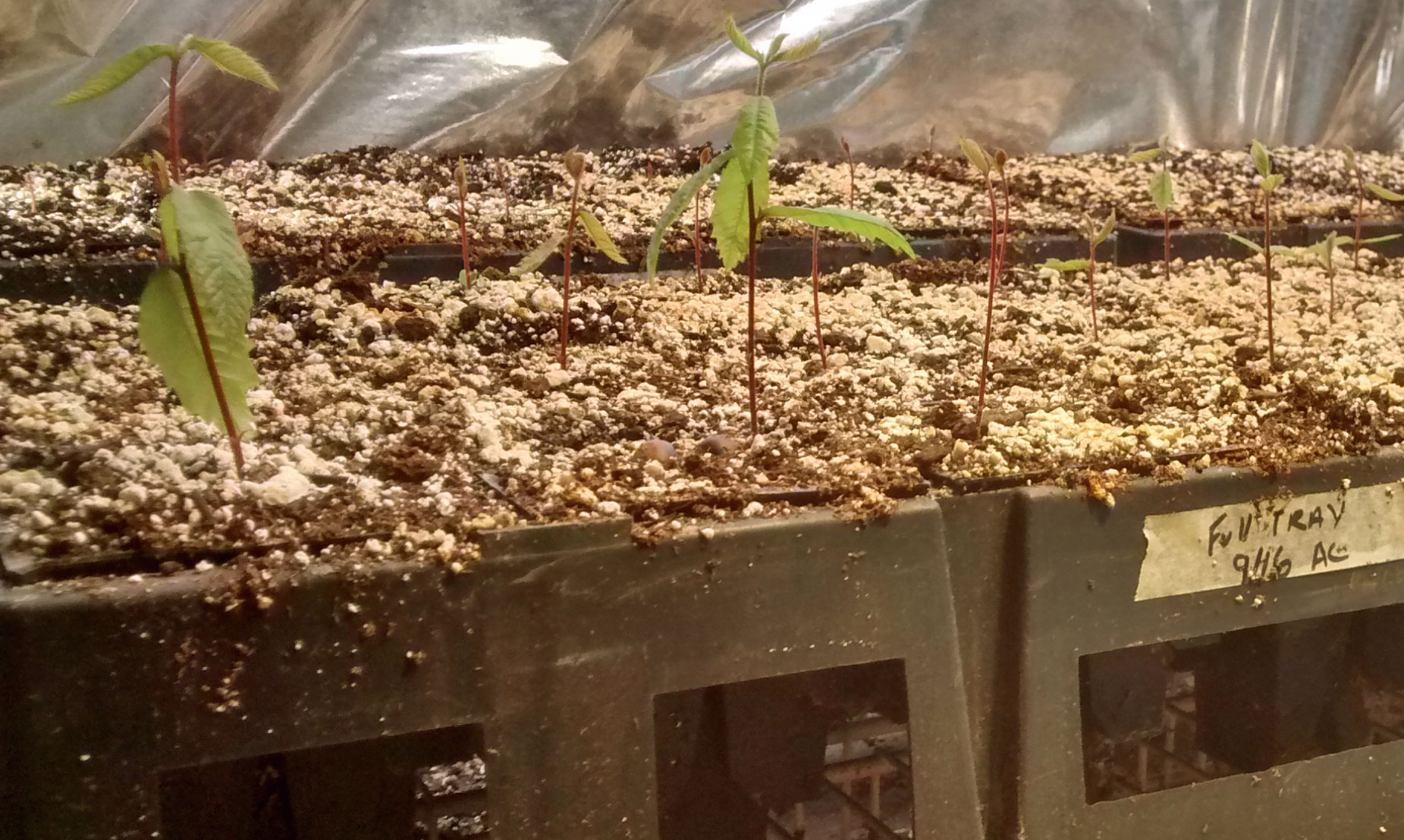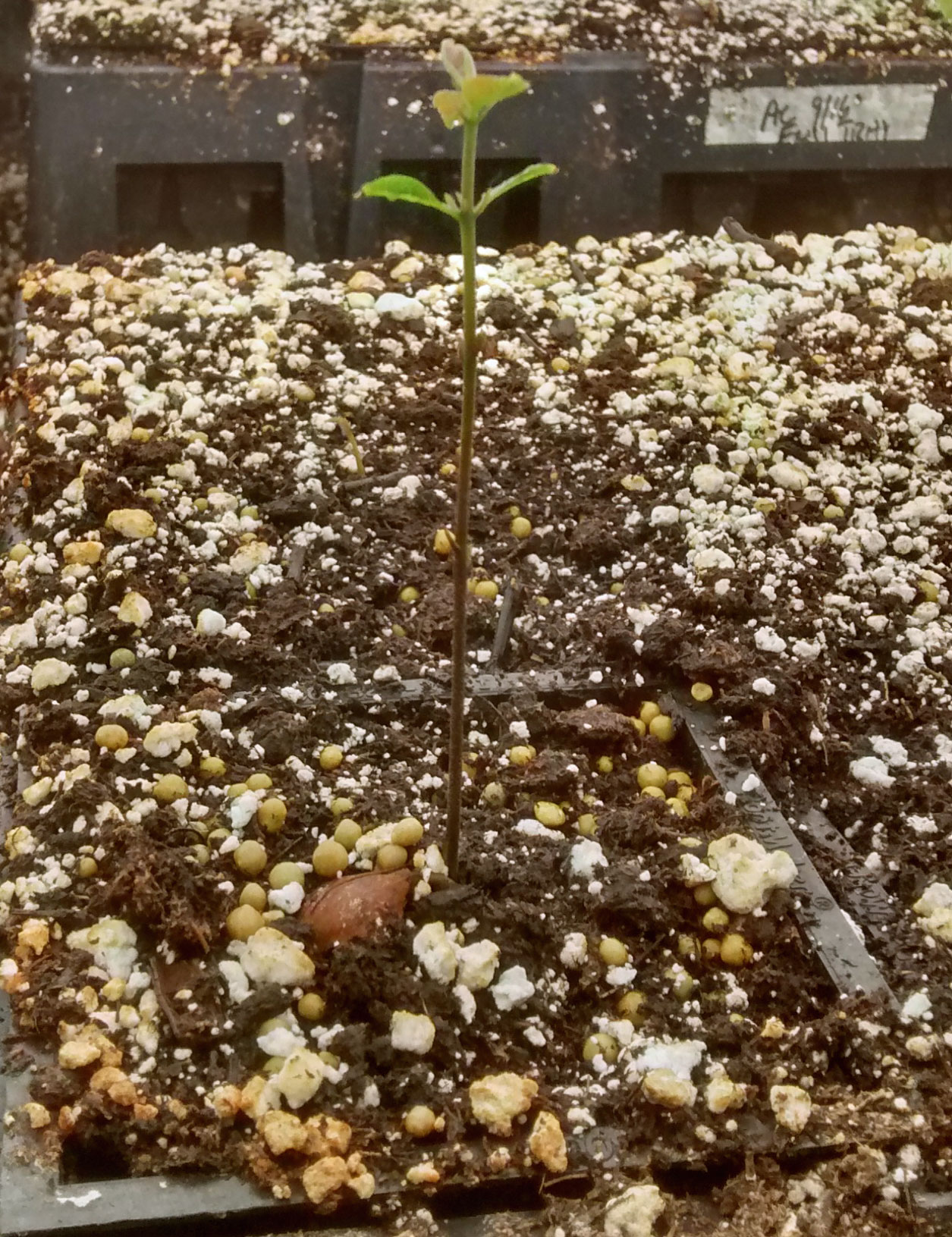You are using an out of date browser. It may not display this or other websites correctly.
You should upgrade or use an alternative browser.
You should upgrade or use an alternative browser.
Seguins - Dwarf Chinese Chestnuts question - Transfered from QDMA forum
- Thread starter yoderjac
- Start date
yoderjac
5 year old buck +
As of today 52 of 66 ACs have top growth. Still only 3 of 8 seguins. Here are a couple pictures:

I reorganize my trees according to height. The ones in the front of the picture are the largest.
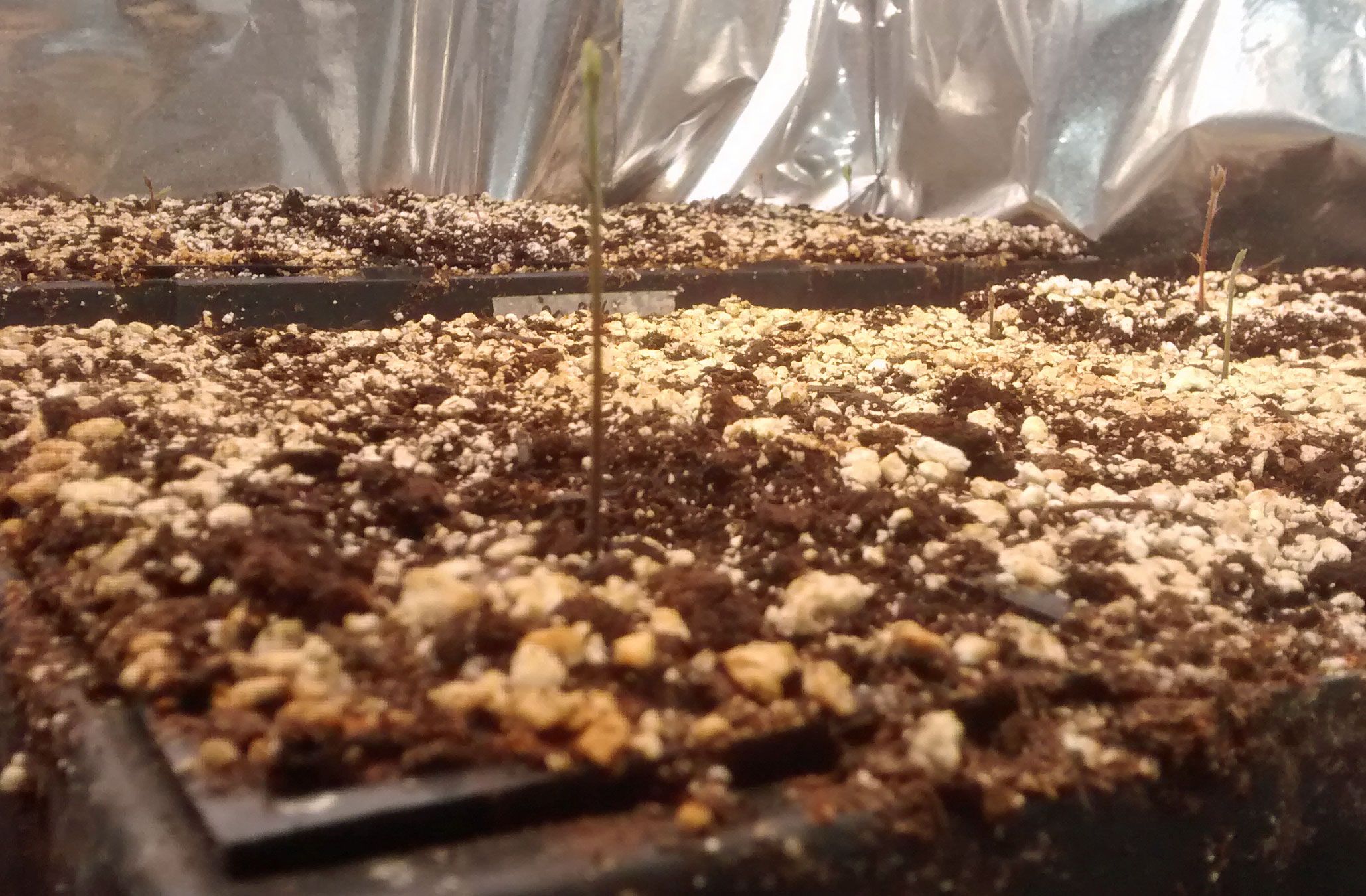
The larger one in the center is a Seguin as well as the one on the right. The one with the red stem is an AC. If you look closely to the left of it, you can see the third seguin just sticking up above the medium a little.
Thanks,
Jack

I reorganize my trees according to height. The ones in the front of the picture are the largest.

The larger one in the center is a Seguin as well as the one on the right. The one with the red stem is an AC. If you look closely to the left of it, you can see the third seguin just sticking up above the medium a little.
Thanks,
Jack
Shedder
5 year old buck +
https://www.acf.org/wp-content/uploads/2016/09/Spring-Summer-Journal-09.pdf?x86657FYI
I have not gone through it in detail yet but the Modelling chestnut biogeography -2012- paper has info on sequins and other species that may be of interest.

Like so.
Also, the CHESTNUTS AND WILDLIFE info has a theory new to me.
In the China article, they also confirm C. seguinii reaches 90 feet. Its dwarf status may be a myth.
yoderjac
5 year old buck +
https://www.acf.org/wp-content/uploads/2016/09/Spring-Summer-Journal-09.pdf?x86657
In the China article, they also confirm C. seguinii reaches 90 feet. Its dwarf status may be a myth.
Very interesting read! Thanks for posting the link! Shows you how deceiving common names can be. I'm now rethinking whether I really want to try to graft seguin to AC or if I should be grafting it to Chinese chestnut.
Thanks,
Jack
yoderjac
5 year old buck +
I've been out of town a while and my Seguins and ACs have grown. The Seguins seem a bit slower than the ACs. It looks like I won't get any more Seguins to germinate but I'm happy with 5 out of 8. The 3 columns on the left are all seguins except for the one in the first row of the third column which is an AC. Of those 8 only 5 show top growth. The rest in the tray are ACs as is the back tray.
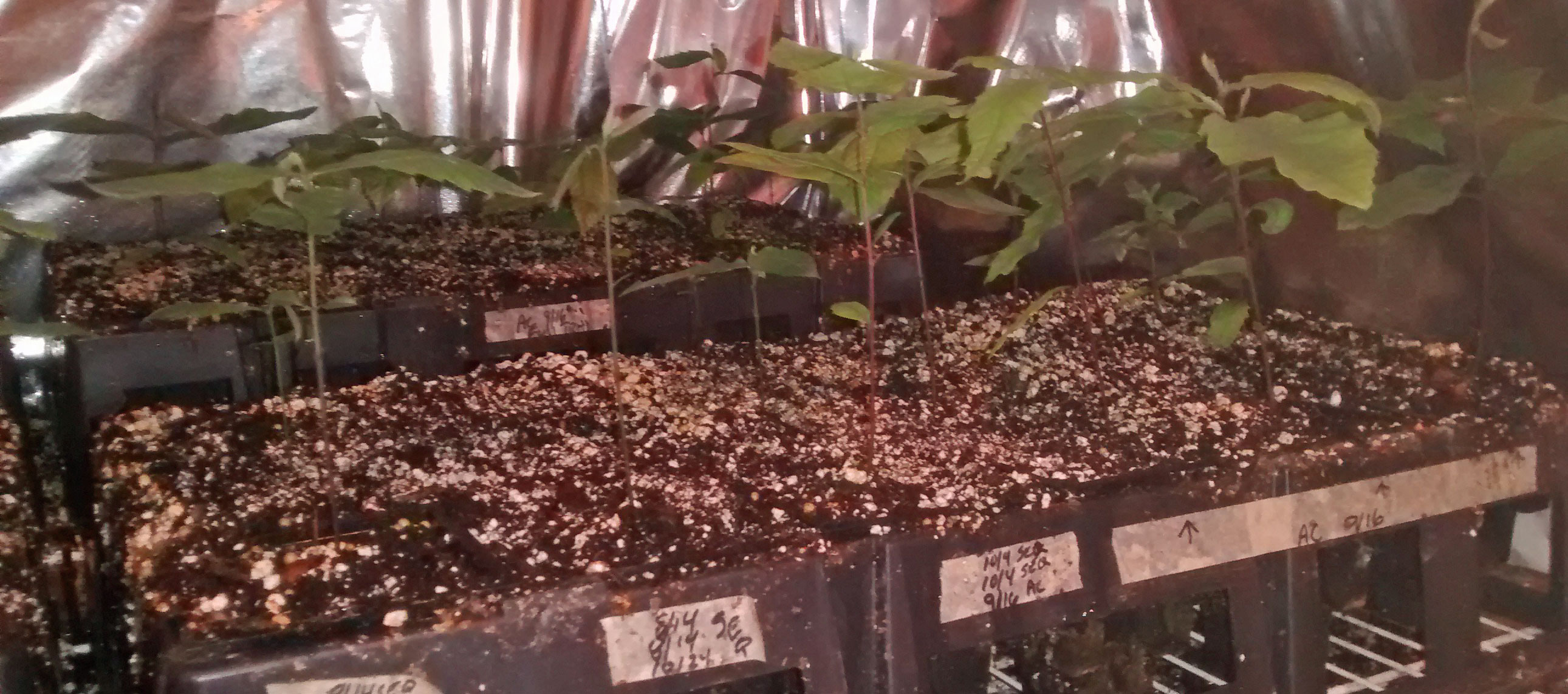
I'm also trying to grow some ACs in the dark for grafting. Only 3 have germinated. Here they are:

I think they are big enough to graft so that is on my agenda for this week.
Thanks,
Jack

I'm also trying to grow some ACs in the dark for grafting. Only 3 have germinated. Here they are:

I think they are big enough to graft so that is on my agenda for this week.
Thanks,
Jack
yoderjac
5 year old buck +
I've tried nut grafting and several forms of seedling grafting with chestnuts with no real success in the past. I think the primary culprit is my fat fingers. I found it almost impossible to use parafilm, tape, or anything working at that micro level. As I mentioned in a previous post, I'm hoping to graft seguins to light deprived Allegheny Chinquapin seedlings. I have no idea if there are compatibility issues or not. I was searching the internet and came across these grafting clips: https://www.highmowingseeds.com/top-grafting-clips-1-5-mm.html Folks evidently use these clips for grafting vegetables. I ordered 25 of the smallest clips they have, 1.5 mm. The came in today so I thought I'd give grafting a shot.
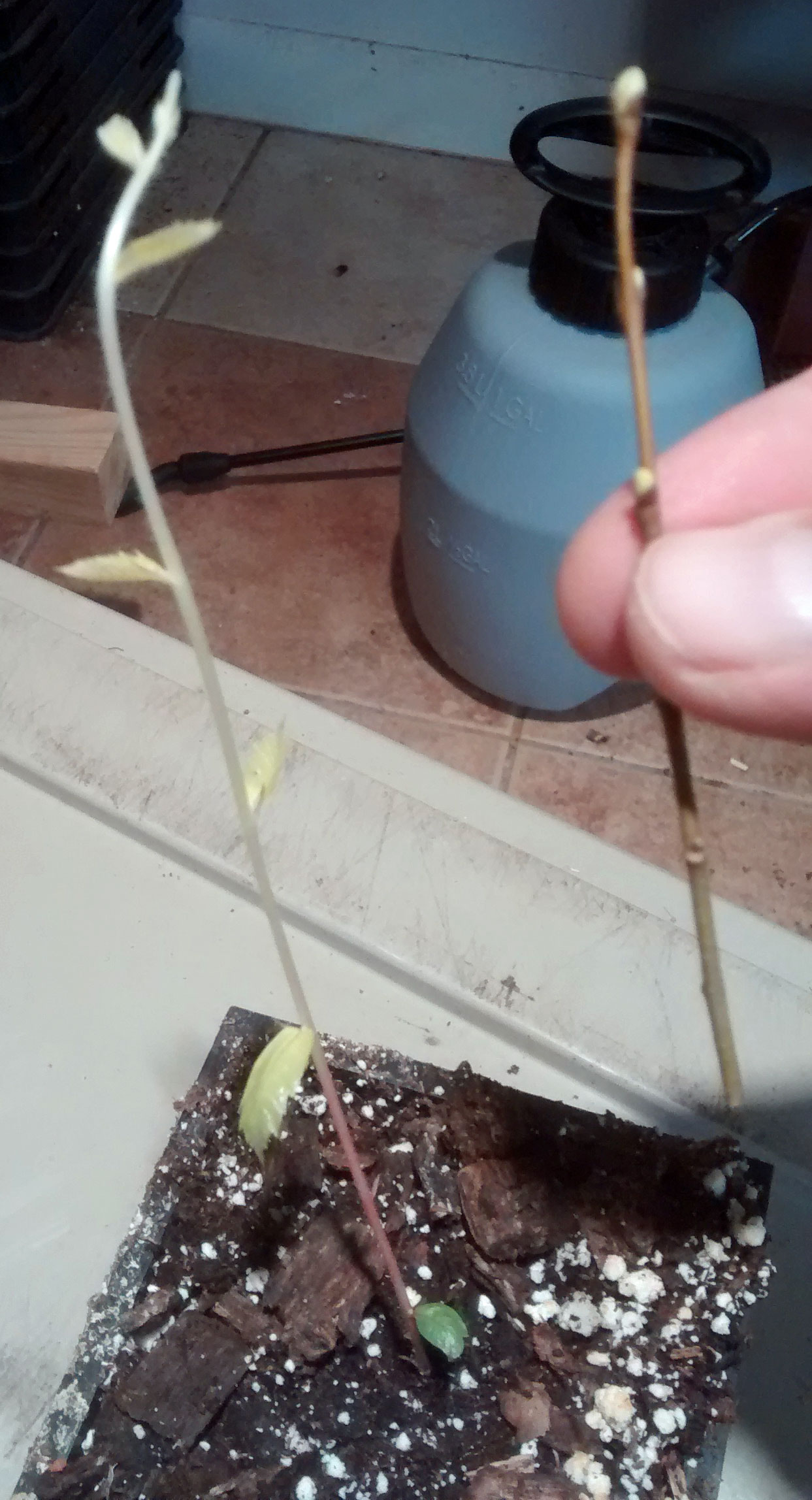
Here is the light deprived AC seedling and the scion from one of my wildlife group seguins. Note how the buds are already green. This could be a mistake on my part. Even in my cold room it is evidently warm enough for these to break dormancy. They are the only trees in my cold room with green buds.
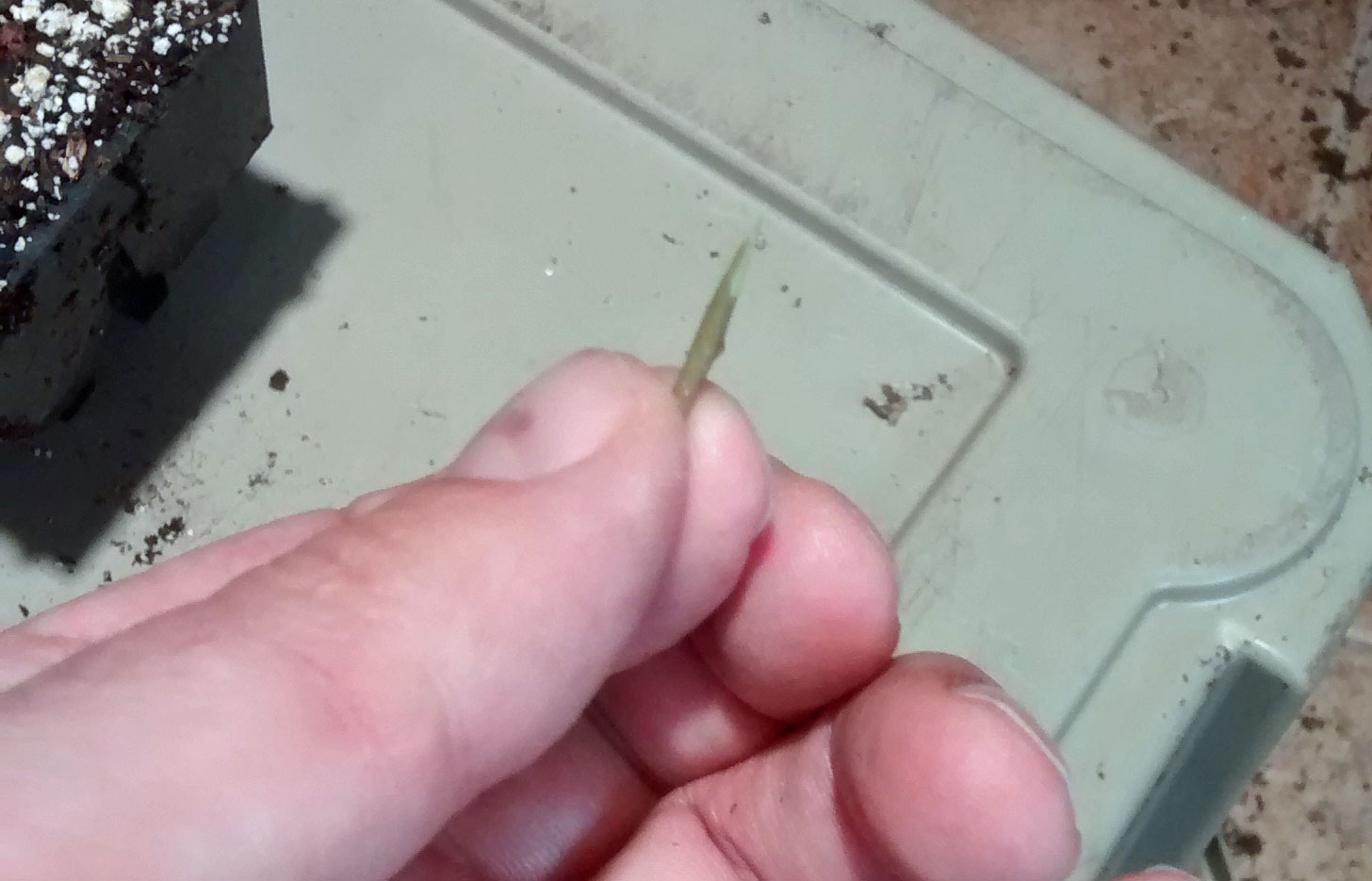
Above is a tiny scion cut as a V.

Here is the scion grafted to the AC with the clip in place.
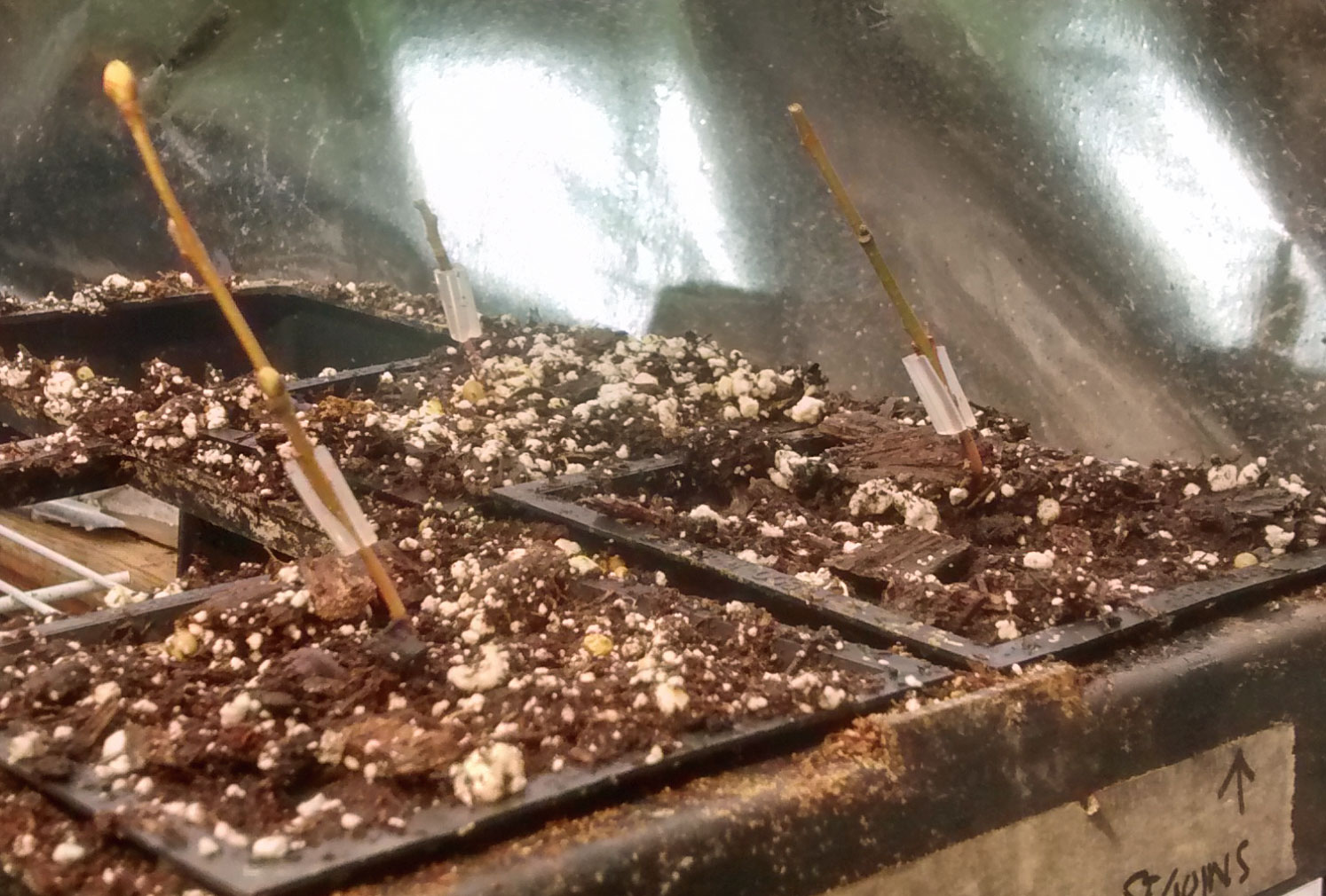
Here are the three grafts I attempted. After thinking about it for a while, I decided 3 green buds would likely overwhelm the small AC nut so I decided to cut it back.
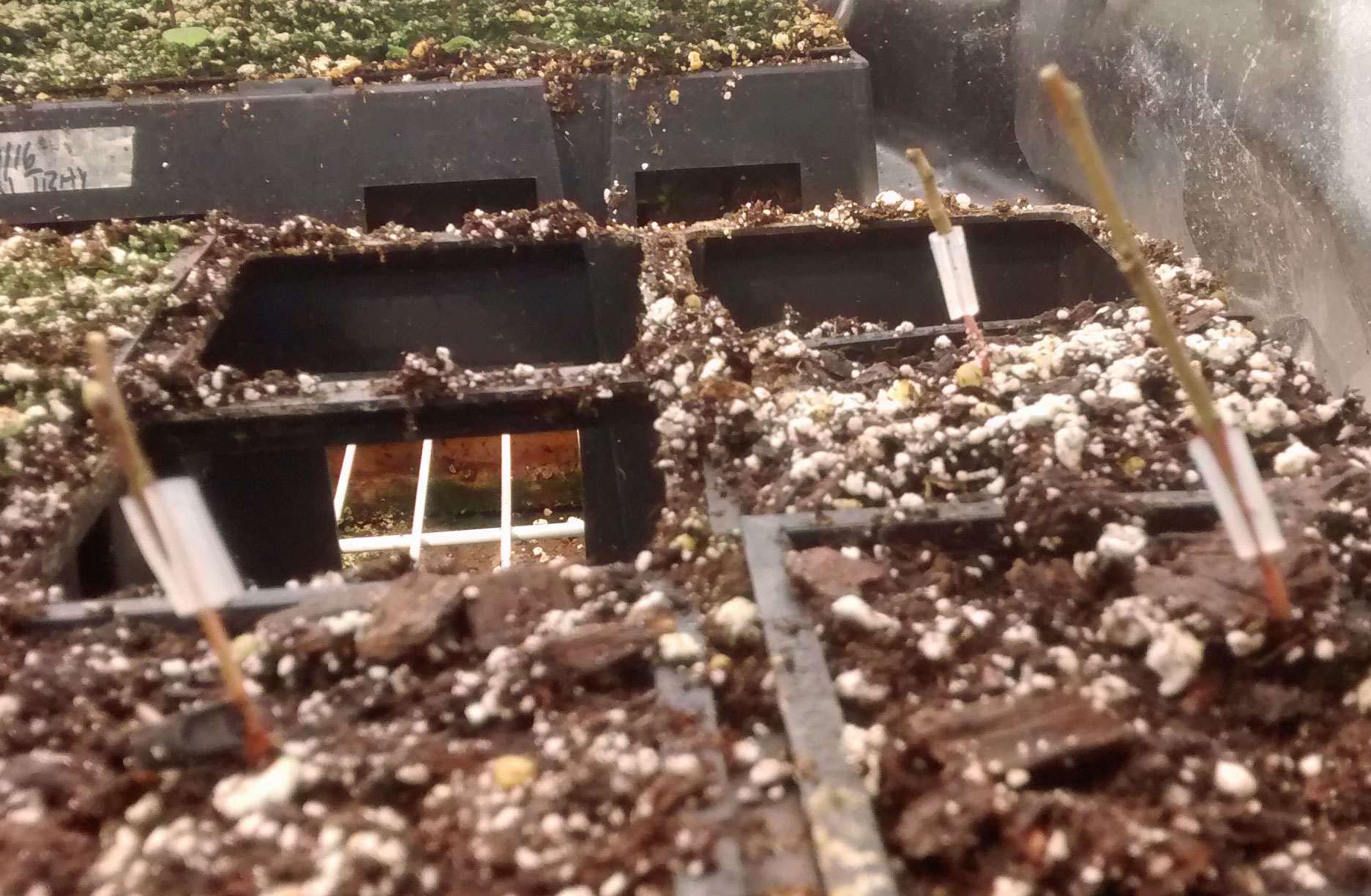
The same three with the one on the left cut back.
Thanks,
Jack

Here is the light deprived AC seedling and the scion from one of my wildlife group seguins. Note how the buds are already green. This could be a mistake on my part. Even in my cold room it is evidently warm enough for these to break dormancy. They are the only trees in my cold room with green buds.

Above is a tiny scion cut as a V.

Here is the scion grafted to the AC with the clip in place.

Here are the three grafts I attempted. After thinking about it for a while, I decided 3 green buds would likely overwhelm the small AC nut so I decided to cut it back.

The same three with the one on the left cut back.
Thanks,
Jack
Shedder
5 year old buck +
https://www.acf.org/wp-content/uploads/2016/09/Spring-Summer-Journal-09.pdf?x86657
In the China article, they also confirm C. seguinii reaches 90 feet. Its dwarf status may be a myth.
http://www.personal.psu.edu/sff3/blogs/chestnuts_in_china/2008/09/zehaos-plot.html
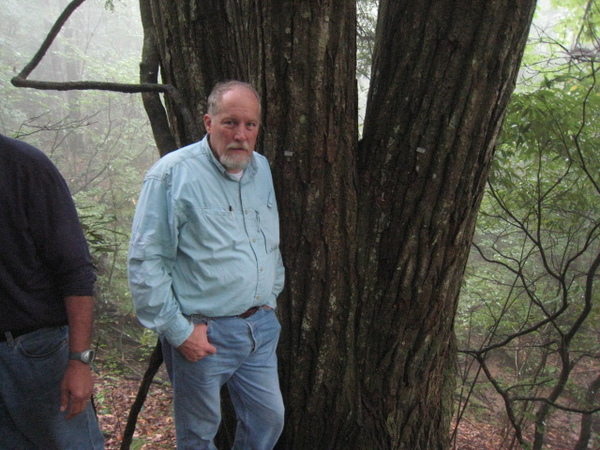
Kim stands next to a large C. seguinii.

Zehao stands next to another C. seguinii individual.
Yes, indeedy. Big.
Shedder
5 year old buck +
Note the comment
"As we were still pretty new to the site and the three species, we still had a bit of trouble keying out the species we saw. Henryi was typically easy to key out - the leaf shape is very distinctive. But mollissima and seguinii are very much alike.
Once up there, we saw some very large trees. And then we started seeing trees that keyed out exactly as Castanea seguinii - according to two keys we had with us - the only difference being that they were over 80 feet tall! In the literature - and with everything I'd heard - the C. seguinii is often referred to as the "dwarf chestnut" and that it rarely reaches heights over 10, 12, or 15 meters (depending on the reference one uses).
But there were some very large chestnuts up there. In fact, the dominant tree in the canopy was either C. henryi or C. seguinii. Based on our observations, we did not see any C. mollissima at Zehao's plot. But with sizes > 20" dbh and most trees over 80feet in height, wonderful, straight form and no evidence of blight infection - not even suspicious lesions like we'd seen below on the road - this was a wonderful place to observe chesntut. And is also a site for us to note for continued observation and collection."
"As we were still pretty new to the site and the three species, we still had a bit of trouble keying out the species we saw. Henryi was typically easy to key out - the leaf shape is very distinctive. But mollissima and seguinii are very much alike.
Once up there, we saw some very large trees. And then we started seeing trees that keyed out exactly as Castanea seguinii - according to two keys we had with us - the only difference being that they were over 80 feet tall! In the literature - and with everything I'd heard - the C. seguinii is often referred to as the "dwarf chestnut" and that it rarely reaches heights over 10, 12, or 15 meters (depending on the reference one uses).
But there were some very large chestnuts up there. In fact, the dominant tree in the canopy was either C. henryi or C. seguinii. Based on our observations, we did not see any C. mollissima at Zehao's plot. But with sizes > 20" dbh and most trees over 80feet in height, wonderful, straight form and no evidence of blight infection - not even suspicious lesions like we'd seen below on the road - this was a wonderful place to observe chesntut. And is also a site for us to note for continued observation and collection."
yoderjac
5 year old buck +
That is outstanding. I assumed I was trading off early production for a small bush like tree. It looks like this tree may be the best of both worlds. The C. Seguinii I got from the Wildlife group were small young seedlings yet they produced nuts in the 3 gal RB2s I put them in on my deck the very first season I had them. I'm presuming it was their second growing season. As the previous posts show, I got 8 nuts total from 3 trees that passed the float test. Five of those 8 have germinated and have top growth. It would be really cool to have a tree that produces that young and can still grow to be a large tree.http://www.personal.psu.edu/sff3/blogs/chestnuts_in_china/2008/09/zehaos-plot.html

Kim stands next to a large C. seguinii.

Zehao stands next to another C. seguinii individual.
Yes, indeedy. Big.
Thanks,
Jack
yoderjac
5 year old buck +
Note the comment
"As we were still pretty new to the site and the three species, we still had a bit of trouble keying out the species we saw. Henryi was typically easy to key out - the leaf shape is very distinctive. But mollissima and seguinii are very much alike.
Once up there, we saw some very large trees. And then we started seeing trees that keyed out exactly as Castanea seguinii - according to two keys we had with us - the only difference being that they were over 80 feet tall! In the literature - and with everything I'd heard - the C. seguinii is often referred to as the "dwarf chestnut" and that it rarely reaches heights over 10, 12, or 15 meters (depending on the reference one uses).
But there were some very large chestnuts up there. In fact, the dominant tree in the canopy was either C. henryi or C. seguinii. Based on our observations, we did not see any C. mollissima at Zehao's plot. But with sizes > 20" dbh and most trees over 80feet in height, wonderful, straight form and no evidence of blight infection - not even suspicious lesions like we'd seen below on the road - this was a wonderful place to observe chesntut. And is also a site for us to note for continued observation and collection."
I hope they collected samples and brought them back for DNA analysis.
Thanks,
Jack
Shedder
5 year old buck +
That is outstanding. I assumed I was trading off early production for a small bush like tree. It looks like this tree may be the best of both worlds. The C. Seguinii I got from the Wildlife group were small young seedlings yet they produced nuts in the 3 gal RB2s I put them in on my deck the very first season I had them. I'm presuming it was their second growing season. As the previous posts show, I got 8 nuts total from 3 trees that passed the float test. Five of those 8 have germinated and have top growth. It would be really cool to have a tree that produces that young and can still grow to be a large tree.
Thanks,
Jack
https://www.facebook.com/groups/272120753285618/permalink/346062985891394/
"Sara Fern Fitzsimmons I am pretty sure those trees at Dalaoling described in the article as C. seguinii are C. mollissima. I disagreed with the assessment in the field that they were seguinii. The assessment was made based on the lack of leaf hairs on the underside of the leaf, which is diagnostic for C. seguinii. C. mollissima is markedly hairy on the underside.......except when the leaves are shady. The trees we examined were creating heavy canopy amongst themselves, and little to light reached many of the leaves.
I do agree that it is difficult to assess species in China. I dont know that we ever truly saw C seguinii in the wild - most of the people we worked with seemed to mix up true species with the common names. The Chinese word for what we were told was C seguinii just means little nut. But mollissima certainly have little nuts, and it doesnt really have any further botanical bearing."
The author disputes the evidence under the link.
yoderjac
5 year old buck +
I haven't seen any signs of life in the Sequin to AC grafts. Who knows whether I had poor technique or they are simply incompatible. My seguins are now under lights and starting to leaf out. I had a couple more ACs grown in the dark germinate and grow. Having no other use for them, just for the heck of it, I decided to try green grafting them. I took a small stem with a couple leaves and grafted it to them with the clips just like the dormant ones. I doubt I'll have success with this but nothing ventured, nothing gained.
Thanks,
Jack
Thanks,
Jack
yoderjac
5 year old buck +
I just received notice that Schumacher seeds has the Seguins in stock
I couldn't resist the temptation and ordered a pound
Restarting this journey as I am infatuated with this little tree
bill
Wish you better luck with Schumacher than I had. Order was delayed several time and then the nuts had mold. Not completely sure they were the right nuts. Zero germinated. They do need cold stratification like other chestnuts. Of the 8 nuts I collected from my wildlife group trees, 5 germinated and are growing just fine. I doubt I'll ever order from Schumacher again.
Let us know how things go for you. Perhaps my bad experience was an anomaly.
Thanks,
Jack
Similar threads
- Replies
- 20
- Views
- 2K
- Replies
- 32
- Views
- 3K
